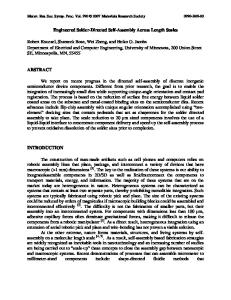Alloy design for mechanical properties: Conquering the length scales
- PDF / 2,623,670 Bytes
- 9 Pages / 585 x 783 pts Page_size
- 85 Downloads / 436 Views
Introduction For at least a century, modeling has played an integral and critical role in alloy design. Two-dimensional maps, equations, and rules are some of the most popular and utilized forms of modeling. Ashby maps have facilitated materials selection, enabling comparisons between classes of alloys against measurable performance indices, such as specific stiffness and yield strength.1 The Hall–Petch scaling law has been used through the years to relate material strength/hardness to grain size in a polycrystal.2,3 The Hume–Rothery rules are widely used to guide the choice of alloying elements to indicate whether the alloy will be single or multiphase.4 While the insights afforded by straightforward rules, expressions, and maps are greatly appreciated, there continues to be a need to develop better materials models. Alloy design has been stretched to encompass more than simply choosing which and how many solute atom(s) to add. Additions of just a few percent of alloying elements can profoundly affect the activation of nanoscale mechanisms (operating over Ångström to nanometer scales) when the alloy is deformed. With heat treatment and mechanical processing, these atomic-scale element
additions can affect the evolution of the internal microstructure (characteristic length scales > nanometer scale). The resulting alloy microstructures are often complex, consisting of multiple phases with each phase containing more than one type of precipitate, particle, or interface. Changes in any of these features can, in turn, influence a broad suite of critical bulk structural properties (samples > millimeter scale), such as strength, ductility, fatigue, fracture, and creep. In order to continue to benefit the design and optimization of alloys, materials models need to be multiscale, spanning from atoms to the continuum. A full-spectrum, “atoms-to-continuum,” multiscale materials model (MMM) for alloy design, however, does not exist. Atomic-scale models that treat a polycrystal as a collective arrangement of atoms exist. Continuum models that treat the sample or structure as a deformable continuum also exist. The modeling components that are missing lie in the intermediate scales, between the nanometer and millimeter scales, collectively referred to as the mesoscale. Crossing the vast mesoscale gap is where MMM meets its greatest challenges.
Irene J. Beyerlein, Department of Mechanical Engineering, Materials Department, University of California, Santa Barbara, USA; [email protected] Shuozhi Xu, California NanoSystems Institute, University of California, Santa Barbara, USA; [email protected] Javier Llorca, IMDEA Materials Institute, and Department of Materials Science, Polytechnic University of Madrid, Spain; [email protected] Jaafar A. El-Awady, Department of Mechanical Engineering, Whiting School of Engineering, Johns Hopkins University, USA; [email protected] Jaber R. Mianroodi, Microstructure Physics and Alloy Design, Max-Planck-Institut für Eisenforschung GmbH; and Material Mechanics, RWTH Aachen University, German
Data Loading...











